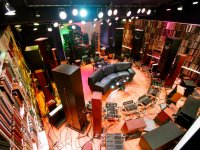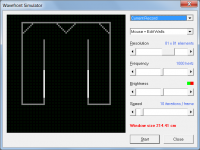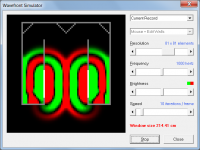So in "real world situations", file corruption is only academicaly possible - you can leave everything as it is...
Hi Sabbelbacke,
Many thanks for clearing this up!
It seems that I was worrying unnecessarily
Kind regards,
David
Hi David, is there a way hornresp can be used to plot the profile of a rectangular horn from a record where the horizontal profile is an arbitrary one or one from another record?
Hi AllenB,
I must be missing something
The necessary calculations can be done very easily in Excel if the horn data is exported as a .csv file.
Kind regards,
David
I hadn't thought of using excel for that. Thanks David
Hi AllenB,
Not a problem
Kind regards,
David
change the name of the setupfile?
Yes I thought there was problems with uploading it?.
or I am wrong not reading well. I responded on older post about site.
A mind-blowing system - in more ways than one.
I'll say.
What a spread. Should be able to do a wee bit of dynamic reproduction with that setup.
Wonder what the driver sizes in the mains are. Looks like a little bit of a mismatch in surface area for linear reproduction at the levels all the other drivers could produce.
A mind-blowing system - in more ways than one.
This picture is worth a quick search to add some context.
This is the $6000000 HT room covered by a bunch of media outlets (websites) a few years ago. It appears to be an old picture (2009 or earlier), the owner's website is gone, the domain name is for sale (he probably went bankrupt), but there's still plenty of sites that host the original content (either copied and pasted or paraphrased I'm not sure). Like this one - $6 Million Home Theater Makes Me Weep | Geekologie
The extravagances include a 4k main projector and a HD background projector (what is a background projector anyway) 4 macbooks, 3 bluray players, 2 HD DVD players, 2 VHS players, 2 Laserdisk players, DVR, HDTV processor and a record player that reads with a laser instead of a needle. This is all high $$$ stuff and that's just the input section so you can see where this is heading...
Over 14000 watts of Class A tube amps heating up that room and the electricity bill and that's not including the sub amps which appear to be Crown pro amps. Hundreds of lit up tubes all around you would seem to be out of place in a normal HT setup but not much about this system is normal.
The write up doesn't agree with the pictures on how many speakers are in the room, but the mains and subs appear to be these Snells as reviewed by Stereophile - Snell Acoustics Type A Reference loudspeaker | Stereophile.com
6 WWMTMWW mains shown in the pics and 12 subs with 18 inch driver and 14 hz ported boxes.
Price for subs as reported by Stereophile is $2499 US each and $6599 each for the mains. Around $70000 worth in subs and mains in the picture, and that's not including his 10 supertweeters and 3 center channels.
The subs exhibited audible chuffing as reported in the review, which is not surprising when looking at the size of the unflared port in the pics. Other than that the speaker look decent although expensive. The subs are spread out through the room but definitely not in optimal subwoofer locations.
Wires and isolation is where it gets really expensive, all identical length wiring for each component (and since the components are all over the place they ALL need long wires).
All Cardas neutral reference, which is $1423 each for 3m speaker wires and $952 each for 2m interconnects.
CARDAS NEUTRAL REFERENCE INTERCONNECTS (PR) at Music Direct
CARDAS NEUTRAL REFERENCE 1.5M FULL RANGE SPADES at Music Direct
And there's another small fortune spent for isolation products, gold fuses and cryo treated breakers as well.
This seems to be the embodiment of "audiophile" system engineering. Throw thousands of dollars at the areas that don't need it (like amps but especially wires) and ignore the good practices that don't cost anything like proper speaker placement. And above all, make sure everything is strewn all about the room and on the floor and in the way so it's an electronic jungle and there's no way that anyone could possibly be mistaken as to how much money you spent.
The system itself seems competent enough and the room sounds well built but at $6000000 it's extremely low value and there's nothing in this room that I would copy if making my own system.
Last edited:
I'll say.
What a spread. Should be able to do a wee bit of dynamic reproduction with that setup.
Wonder what the driver sizes in the mains are. Looks like a little bit of a mismatch in surface area for linear reproduction at the levels all the other drivers could produce.
As per the stereophile review linked above the mains are WWMTMWW with 6.5, 5 and 1 inch drivers.
I'm guessing this system can do THX reference level spl but not a whole lot more.
On the topic of HT it seems everything has become obsolete in the last year or so.
With Dolby Atmos all the regular 5.1 (actually any number .1) are old news. Atmos spec allows for up to 24.1.10 (24 surrounding speakers, one sub and 10 overhead speakers).
AVS Forum | Home Theater Discussions And Reviews - Buyers Guide Introduction
Most available reasonably price receivers and processors can do up to 9.1.2 or 7.1.4 at this time but it won't be long before we see systems that can do the full 24.1.10 at avsforum.
And if you bought into 4k early EVERYTHING electronic is now obsolete due to HDCP 2.2, which is hardware level DRM.
And it's just a matter of time until HDCP is updated again making everything obsolete again. Media makers at are war with their own customers using DRM as the weapon. DRM has never stopped media duplication and applying it at hardware level hurts no one but honest customers.
Fortunately it's easy to get into the game with Atmos, receivers are available under $1000 and comply the with new current HDCP protocol. I don't really care about 4k anyway and don't have any old HDCP equipment so I might check out Atmos within the next couple of years. I'm still strictly stereo and have been meaning to add multiple channels anyway. I'll probably budget under $6000000.
With Dolby Atmos all the regular 5.1 (actually any number .1) are old news. Atmos spec allows for up to 24.1.10 (24 surrounding speakers, one sub and 10 overhead speakers).
AVS Forum | Home Theater Discussions And Reviews - Buyers Guide Introduction
Most available reasonably price receivers and processors can do up to 9.1.2 or 7.1.4 at this time but it won't be long before we see systems that can do the full 24.1.10 at avsforum.
And if you bought into 4k early EVERYTHING electronic is now obsolete due to HDCP 2.2, which is hardware level DRM.
HDCP 2.2 will frustrate consumers more than piratesHDCP 2.2 is not backward compatible with the previous versions of HDCP that are currently used by most of the HD devices in all our homes. Thanks to its ignominious track record of exploitations, the protocol required a clean refresh, and since it's implemented at the hardware level, manufacturers can't simply release new firmware to bring old gear up to speed.
In order to watch copy-protected Ultra HD content--be it on a disc, a download, or via an over-the-top stream—you’ll need HDCP 2.2 compatible devices at every link in the signal chain. Because this isn’t just about media players and TVs; it applies to any component with an HDMI connection. Having a non-HDCP 2.2 sound bar or AV receiver in your home theater system will be enough to terminate the handshake and your afternoon plans for watching The Godfather in glorious 4K resolution.
And it's just a matter of time until HDCP is updated again making everything obsolete again. Media makers at are war with their own customers using DRM as the weapon. DRM has never stopped media duplication and applying it at hardware level hurts no one but honest customers.
Fortunately it's easy to get into the game with Atmos, receivers are available under $1000 and comply the with new current HDCP protocol. I don't really care about 4k anyway and don't have any old HDCP equipment so I might check out Atmos within the next couple of years. I'm still strictly stereo and have been meaning to add multiple channels anyway. I'll probably budget under $6000000.
This picture is worth a quick search to add some context.
Hi just a guy,
Thanks for providing the background information!
$6M seems rather a lot of money to spend on a Home Theatre system - and there aren't even any horns
Kind regards,
David
Acoustical Blivit followed by Exteem Nonsense
a) The listening space is acoustically too-small too meet the system's mission.
b) For $6-Million you can build several modern equivalents of an Imax Theater and/or Hot Disco Club;
and, make a lot of money from the effort while enjoying the 'show' (as well as the tell).
Most sound/light systems found at typical venues perform like they were designed and installed by armatures on too-limited budgets.
For the case at hand, the budget was too-unlimited.
WHG
a) The listening space is acoustically too-small too meet the system's mission.
b) For $6-Million you can build several modern equivalents of an Imax Theater and/or Hot Disco Club;
and, make a lot of money from the effort while enjoying the 'show' (as well as the tell).
Most sound/light systems found at typical venues perform like they were designed and installed by armatures on too-limited budgets.
For the case at hand, the budget was too-unlimited.
WHG
Last edited:
Hornresp Update 3940-160101
Hi Everyone,
The following changes have been made to the Wavefront Simulator tool.
1. A grid is now displayed when in Edit mode (see attachment 1).
2. Driver polarity is now specified by the order in which the diaphragm end points are set. Multiple drivers can have different polarities (see attachment 2).
See the Wavefront Simulator description in the Tools Menu section of the Hornresp Help file for further details.
Kind regards,
David
Hi Everyone,
The following changes have been made to the Wavefront Simulator tool.
1. A grid is now displayed when in Edit mode (see attachment 1).
2. Driver polarity is now specified by the order in which the diaphragm end points are set. Multiple drivers can have different polarities (see attachment 2).
See the Wavefront Simulator description in the Tools Menu section of the Hornresp Help file for further details.
Kind regards,
David
Attachments
Hi Everyone,
The following changes have been made to the Wavefront Simulator tool.
1. A grid is now displayed when in Edit mode (see attachment 1).
2. Driver polarity is now specified by the order in which the diaphragm end points are set. Multiple drivers can have different polarities (see attachment 2).
See the Wavefront Simulator description in the Tools Menu section of the Hornresp Help file for further details.
Kind regards,
David
Nice!
Will prove to be very useful. Thanks David.
Hoping all a happy new year.
Onward and upward.
Hi Everyone,
The following changes have been made to the Wavefront Simulator tool.
1. A grid is now displayed when in Edit mode (see attachment 1).
2. Driver polarity is now specified by the order in which the diaphragm end points are set. Multiple drivers can have different polarities (see attachment 2).
See the Wavefront Simulator description in the Tools Menu section of the Hornresp Help file for further details.
Kind regards,
David
Out of curiosity, how hard would it be to implement a delay parameter in the wave tank simulator?
I tried to do it myself, but after three days of hacking my results weren't that great.
The reason that delay would be useful is that it would allow people to sim end fire arrays. And if I'm not mistaken, there are no programs readily available that can do that.
For instance, if you have two woofers in the sim, you delay one woofer by one millisecond so that the output of the woofer is aligned with a second woofer that's 34cm behind the first. The one millisecond delay aligns their wavefronts and creates a cardioid response.
- Home
- Loudspeakers
- Subwoofers
- Hornresp


